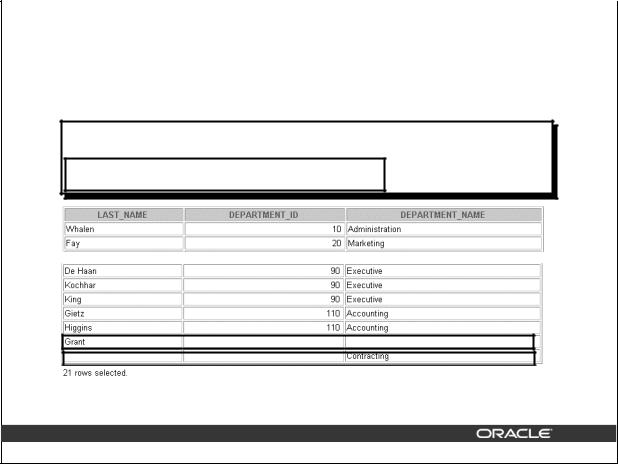
Semestr2 / 1 - Oracle / Student_1-8
.pdf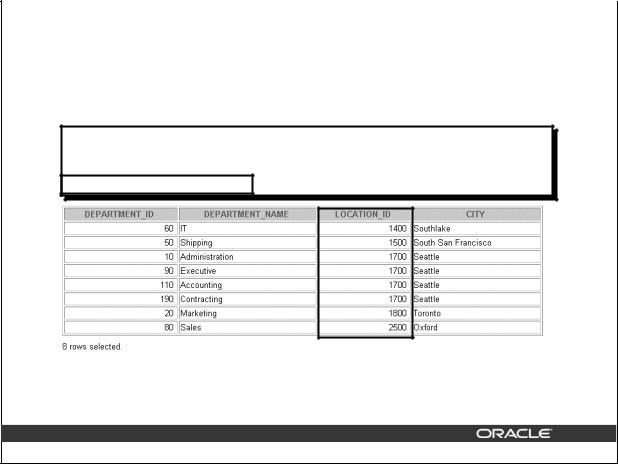
Retrieving Records with Natural Joins
SELECT department_id, department_name, location_id, city
FROM departments NATURAL JOIN locations ;
4-25 |
Copyright © Oracle Corporation, 2001. All rights reserved. |
Retrieving Records with Natural Joins
In the example on the slide, the LOCATIONS table is joined to the DEPARTMENT table by the LOCATION_ID column, which is the only column of the same name in both tables. If other common columns were present, the join would have used them all.
Equijoins
The natural join can also be written as an equijoin:
SELECT department_id, department_name, departments.location_id, city
FROM departments, locations
WHERE departments.location_id = locations.location_id;
Natural Joins with a WHERE Clause
Additional restrictions on a natural join are implemented by using a WHERE clause. The example below limits the rows of output to those with a department ID equal to 20 or 50.
SELECT department_id, department_name, location_id, city
FROM departments NATURAL JOIN locations
WHERE department_id IN (20, 50);
Introduction to Oracle9i: SQL Basics 4-25

Creating Joins with the USING Clause
•If several columns have the same names but the data types do not match, the NATURAL JOIN clause can be modified with the USING clause to specify the columns that should be used for an equijoin.
•Use the USING clause to match only one column when more than one column matches.
•Do not use a table name or alias in the referenced columns.
•The NATURAL JOIN and USING clauses are mutually exclusive.
4-26 |
Copyright © Oracle Corporation, 2001. All rights reserved. |
The USING Clause
Natural joins use all columns with matching names and data types to join the tables. The USING clause can be used to specify only those columns that should be used for an equijoin. The columns referenced in the USING clause should not have a qualifier (table name or alias) anywhere in the SQL statement.
For example, this statement is valid:
SELECT |
l.city, d.department_name |
FROM |
locations l JOIN departments d USING (location_id) |
WHERE |
location_id = 1400; |
This statement is invalid because the LOCATION_ID is qualified in the WHERE clause:
SELECT l.city, d.department_name
FROM locations l JOIN departments d USING (location_id) WHERE d.location_id = 1400;
ORA-25154: column part of USING clause cannot have qualifier
The same restriction applies to NATURAL joins also. Therefore columns that have the same name in both tables have to be used without any qualifiers.
Introduction to Oracle9i: SQL Basics 4-26
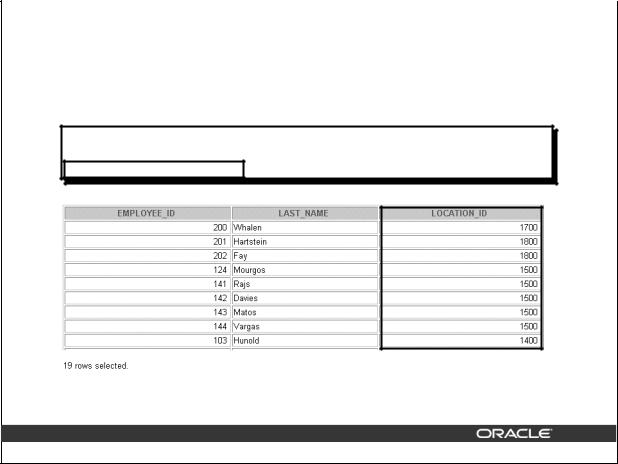
Retrieving Records with the USING Clause
SELECT e.employee_id, e.last_name, d.location_id
FROM employees e JOIN departments d
USING (department_id) ;
…
4-27 |
Copyright © Oracle Corporation, 2001. All rights reserved. |
The USING Clause (continued)
The example shown joins the DEPARTMENT_ID column in the EMPLOYEES and DEPARTMENTS tables, and thus shows the location where an employee works.
This can also be written as an equijoin:
SELECT employee_id, last_name, employees.department_id, location_id
FROM employees, departments
WHERE employees.department_id = departments.department_id;
Introduction to Oracle9i: SQL Basics 4-27

Creating Joins with the ON Clause
•The join condition for the natural join is basically an equijoin of all columns with the same name.
•To specify arbitrary conditions or specify columns to join, the ON clause is used.
•The join condition is separated from other search conditions.
•The ON clause makes code easy to understand.
4-28 |
Copyright © Oracle Corporation, 2001. All rights reserved. |
The ON Condition
Use the ON clause to specify a join condition. This lets you specify join conditions separate from any search or filter conditions in the WHERE clause.
Introduction to Oracle9i: SQL Basics 4-28
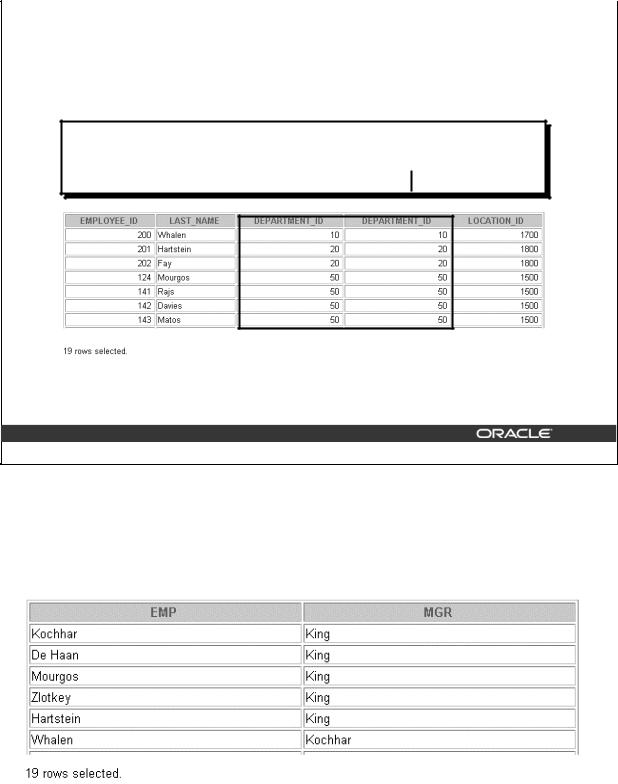
Retrieving Records with the ON Clause
SELECT e.employee_id, e.last_name, e.department_id,
|
d.department_id, d.location_id |
|
FROM |
employees e JOIN departments d |
|
ON |
(e.department_id = d.department_id); |
|
|
|
|
…
4-29 |
Copyright © Oracle Corporation, 2001. All rights reserved. |
Creating Joins with the ON Clause
The ON clause can also be used as follows to join columns that have different names:
SELECT |
e.last_name emp, m.last_name mgr |
FROM |
employees e JOIN employees m |
ON |
(e.manager_id = m.employee_id); |
…
The preceding example is a selfjoin of the EMPLOYEE table to itself, based on the EMPLOYEE_ID and MANAGER_ID columns.
Introduction to Oracle9i: SQL Basics 4-29
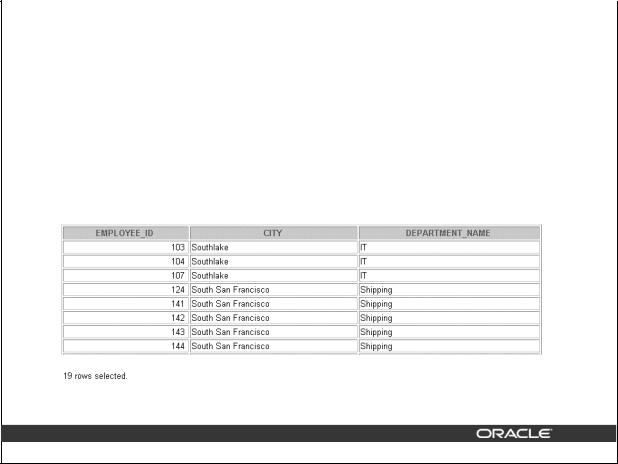
Creating Three-Way Joins with the ON
Clause
|
SELECT |
employee_id, city, department_name |
|
|
|
|
|||
|
FROM |
employees e |
|
|
|
JOIN |
departments d |
|
|
|
ON |
d.department_id = e.department_id |
|
|
|
JOIN |
locations l |
|
|
|
ON |
d.location_id = l.location_id; |
|
|
|
|
|
|
|
…
4-30 |
Copyright © Oracle Corporation, 2001. All rights reserved. |
Three-Way Joins
A three-way join is a join of three tables. In SQL: 1999 compliant syntax, joins are performed from left to right so the first join to be performed is EMPLOYEES JOIN DEPARTMENTS. The first join condition can reference columns in EMPLOYEES and DEPARTMENTS but cannot reference columns in LOCATIONS. The second join condition can reference columns from all three tables.
This can also be written as a three-way equijoin:
SELECT |
employee_id, city, department_name |
||
FROM |
employees, departments, locations |
||
WHERE |
employees.department_id |
= |
departments.department_id |
AND |
departments.location_id |
= |
locations.location_id; |
Introduction to Oracle9i: SQL Basics 4-30

INNER Versus OUTER Joins
•In SQL: 1999, the join of two tables returning only matched rows is an inner join.
•A join between two tables that returns the results of the inner join as well as unmatched rows left (or right) tables is a left (or right) outer join.
•A join between two tables that returns the results of an inner join as well as the results of a left and right join is a full outer join.
4-31 Copyright © Oracle Corporation, 2001. All rights reserved.
Joins - Comparing SQL: 1999 to Oracle Syntax
Oracle |
SQL: 1999 |
|
|
Equi-Join |
Natural/Inner Join |
|
|
Outer-Join |
Left Outer Join |
|
|
Self-Join |
Join ON |
|
|
Non-Equi-Join |
Join USING |
|
|
Cartesian Product |
Cross Join |
|
|
Introduction to Oracle9i: SQL Basics 4-31
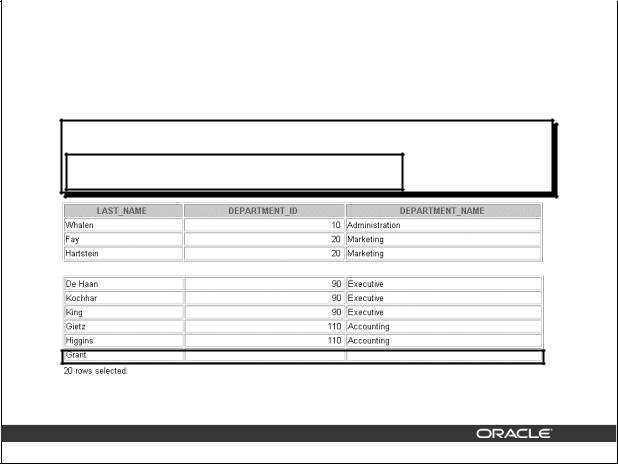
LEFT OUTER JOIN
SELECT e.last_name, e.department_id, d.department_name FROM employees e
LEFT OUTER JOIN departments d
ON (e.department_id = d.department_id) ;
…
4-32 |
Copyright © Oracle Corporation, 2001. All rights reserved. |
Example of LEFT OUTER JOIN
This query retrieves all rows in the EMPLOYEES table, which is the left table even if there is no match in the DEPARTMENTS table.
This query was completed in earlier releases as follows:
SELECT e.last_name, e.department_id, d.department_name FROM employees e, departments d
WHERE d.department_id (+) = e.department_id;
Introduction to Oracle9i: SQL Basics 4-32
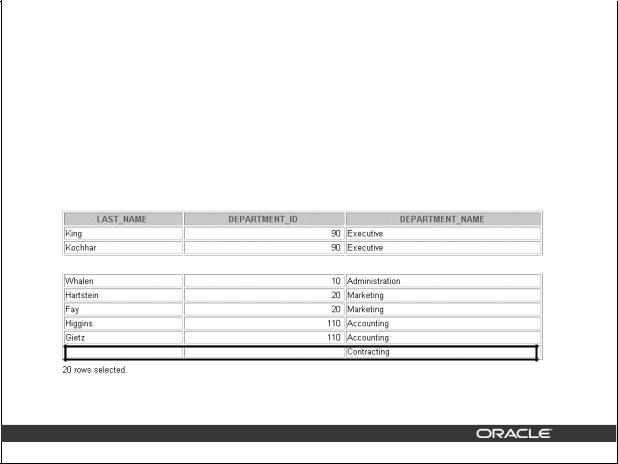
RIGHT OUTER JOIN
|
SELECT |
e.last_name, e.department_id, d.department_name |
|
|
|
|
|||
|
FROM |
employees e |
|
|
|
RIGHT |
OUTER JOIN departments d |
|
|
|
ON |
(e.department_id = d.department_id) |
; |
|
|
|
|
|
|
|
|
|
|
|
…
4-33 |
Copyright © Oracle Corporation, 2001. All rights reserved. |
Example of RIGHT OUTER JOIN
This query retrieves all rows in the DEPARTMENTS table, which is the right table even if there is no match in the EMPLOYEES table.
This query was completed in earlier releases as follows:
SELECT e.last_name, e.department_id, d.department_name FROM employees e, departments d
WHERE d.department_id = e.department_id (+);
Introduction to Oracle9i: SQL Basics 4-33
